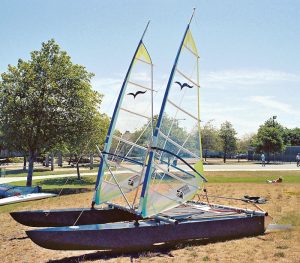AC Zzzzzz?
Ben Cesare’s November/December 2024 Publisher’s Log, “The Amazing America’s Cup” (windcheckmagazine.com/article/the-amazing-americas-cup/) resonated with many.
Ben,
Well said. The 37th America’s Cup was boring. I would like to see a lot more time in the box fighting it out for position. I love sailing and especially match race sailing, but found myself not even caring that racing was on.
Best,
Paul Grenauer
Ben,
Firstly, these are not yachts, or yacht racing with a sailing crew.
They are at best a scientific experiment. Can we make monohulls fly, and yes we have achieved that but at what cost?
Did we see sailors racing around the yacht, undertaking maneuvers where all the crew were involved? No, the sailors never left their seats, and while turns were executed smoothly all the excitement that once lived here is gone.
If you nodded off during the race then tuned back in, could you tell at a glance if the boats were going up or downwind? Yes, the format and the boats contributed to a boring event. Now it’s time to revisit the idea of yacht racing, where at this level you really need to be good, solid yachtsmen to compete.
Name withheld…this is a small country where like Cheers everyone knows your name.
An open letter to Grant Dalton, Emirates Team New Zealand
Dear Mr. Dalton,
Congratulations on winning the 37th America’s Cup.
I am writing to propose a new design and source of funds for the boats for the next Cup. I am an engineer/inventor with 40 patents in aerodynamics, hydrodynamics, and other fields. I designed this planing catamaran which sails at 30 mph, lifting out of the water on stepped hulls. When first planing, the total wetted surface is about four square feet. As speed increases, the hulls lift out of the water, further reducing wetted surface. An article about this boat can be found at proboat.com/2019/12/take-a-free-copy/
I also designed the production class Fast-40 and the 60-foot aluminum ketch Etosha, which won her class in the Singlehanded Transatlantic Race. I invented the Aerobie flying ring, the world’s farthest thrown object (406 meters), and many other aerodynamic devices.
Although the present AC foiling monohulls are an amazing achievement, planing multihulls are almost as fast and would provide closer racing for spectators at much lower cost and without the need for cyclors. My proposal is self-financing and would relieve your team from fundraising.

In addition to being almost as fast as foilers, stepped planing multihulls obviously cannot fall off of their foils and would provide closer, more exciting racing.
You would make all of the competing boats and sell them to challengers. That would reduce the cost of challenging by several orders of magnitude. It would facilitate challenges from more than one yacht club in each nation. Sailing countries like the USA, Britain, France and Australia would send multiple challenges. It is probable that there would be more than thirty challenges. It would elevate the America’s Cup to a level never before imagined.
After the AC challenger has been selected by the LV Cup, the AC Cup competitors would trade boats each race to ensure that it was a race of sailing (rather than design) skill. New Zealanders are amongst the greatest sailors in the world and would be favorites to retain the Cup. And there would be zero cost to your team, having sold dozens of boats to challengers at a fair profit on each one. Challengers would embrace this program with open arms as it would be fair and affordable.
Planing multihulls can be catamarans or trimarans. If cats, I suggest a central crew pod to eliminate running back and forth between hulls. I also suggest a biplane rig, like my boat pictured. The biplane rig has a lower heeling moment and is the best rig for fast boats which race with the apparent wind forward on all points of sail.
If trimarans, the amas should be offset forward of the center hull to align them with the thrust vector from the sail and eliminate the chance of pitchpoling.
I seek no compensation. The patent on my planing cat has expired and I am comfortably retired.
I hope you will share this message with your designers. They can tailor their simulators to simulate stepped planing hulls, which have an L/D of about ten. I am available to help with technical matters. I have lectured on aerodynamics at NASA three times, Stanford University ten times, as well as Cal-Tech, Princeton and the Royal Aeronautical Society in London.
Sincerely yours,
Alan Adler ■




